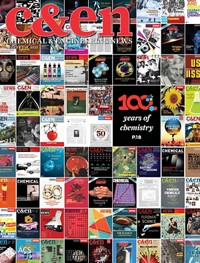Advertisement
Grab your lab coat. Let's get started
Welcome!
Welcome!
Create an account below to get 6 C&EN articles per month, receive newsletters and more - all free.
It seems this is your first time logging in online. Please enter the following information to continue.
As an ACS member you automatically get access to this site. All we need is few more details to create your reading experience.
Not you? Sign in with a different account.
Not you? Sign in with a different account.
ERROR 1
ERROR 1
ERROR 2
ERROR 2
ERROR 2
ERROR 2
ERROR 2
Password and Confirm password must match.
If you have an ACS member number, please enter it here so we can link this account to your membership. (optional)
ERROR 2
ACS values your privacy. By submitting your information, you are gaining access to C&EN and subscribing to our weekly newsletter. We use the information you provide to make your reading experience better, and we will never sell your data to third party members.
Publishing
Editorial: A packed issue of C&EN
by Michael McCoy
February 4, 2024
| A version of this story appeared in
Volume 102, Issue 4
Taking the reader on a walk through a magazine’s features is the easy way out for an editorial writer, but I want to do it this week—to showcase the stories and their writers and to brag about how far C&EN has come in the past year.
Throughout much of 2023, our staff was depleted, and we struggled to put out satisfyingly full magazines. Of course, every issue had a cover story and a nice selection of news articles, but many contained only two of the feature stories that are the bread and butter of any magazine.
Thanks to a sustained hiring program and contributions from freelance writers, C&EN is a lot more robust this year. And the issue in your hands—or on your screen—is a great example.
The cover story (page 30) was written by Laurel Oldach, a PhD pharmacologist who joined C&EN in late 2022. In the story, Oldach explains how advances in cryo-electron microscopy are allowing biochemists to move beyond studying proteins in isolation to exploring them in their complex cellular environments. The story is beautifully written and illustrated.
The first story in the features section (page 19) is by Krystal Vasquez, a PhD atmospheric chemist who joined C&EN last April; she had previously served as an editorial fellow with the magazine. The piece thoughtfully details the challenges that chemists with disabilities face in the lab and explores some of the ways they are overcoming them.
Prachi Patel, one of the newest reporters on the C&EN team, wrote an intriguing article about the technologies chemists are developing to destroy atmospheric methane—a potent greenhouse gas that gets less attention than carbon dioxide but is almost as damaging to the environment (page 25). Patel is a computer and electrical engineer who joined the magazine in December after a long career as a freelance writer for C&EN and other publications.
Matt Blois, who has been with the magazine since 2021, deftly combines business and science in his story about a new generation of lithium-ion batteries that contain silicon in their anodes (page 22). Finally, Katsumori Matsuoka, a freelance writer who worked for many years for Japan’sChemical Daily, explains the predicament faced by Japan’s petrochemical industry and how executives hope to escape it (page 28).
Other staffers hired in recent months are contributing as well. Two new reporters on the life sciences beat, Sarah Braner and Rowan Walrath, wrote news stories for this week’s issue. And another new hire, Priyanka Runwal, just returned from a reporting trip to eastern Ohio for a story about the town of East Palestine 1 year after a train wreck spilled vinyl chloride and other dangerous chemicals.
And we’re not quite done rebuilding. Our two newest newsroom members—business reporter Aayushi Pratap and physical sciences reporter Fionna Samuels—start this month.
C&EN is fortunate to be hiring during a bleak period for the news media. The Los Angeles Times laid off about 20% of its news staff last month; Sports Illustrated is letting much of its staff go. Sources at the Washington Post and Time magazine acknowledged recently that their publications lost money in 2023.
And Bloomberg Businessweek, a fellow weekly publication that is almost as old as C&EN, will be going monthly later this year. It hasn’t said whether its name will change.
C&EN is not immune to the media’s woes. We require a subsidy from our publisher, the American Chemical Society, to survive, and like Businessweek, we won’t be a weekly magazine forever. Yet ACS rightly sees us as an important society benefit that attracts new members and encourages old ones to keep renewing.
I’m biased, but I think C&EN issues like this one will make any chemist happy with their membership in ACS.
Views expressed on this page are those of the author and not necessarily those of ACS.



Join the conversation
Contact the reporter
Submit a Letter to the Editor for publication
Engage with us on Twitter